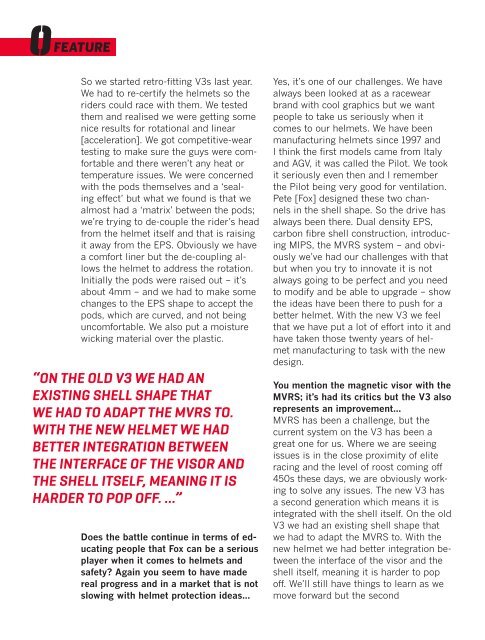You also want an ePaper? Increase the reach of your titles
YUMPU automatically turns print PDFs into web optimized ePapers that Google loves.
FEATURE<br />
So we started retro-fitting V3s last year.<br />
We had to re-certify the helmets so the<br />
riders could race with them. We tested<br />
them and realised we were getting some<br />
nice results for rotational and linear<br />
[acceleration]. We got competitive-wear<br />
testing to make sure the guys were comfortable<br />
and there weren’t any heat or<br />
temperature issues. We were concerned<br />
with the pods themselves and a ‘sealing<br />
effect’ but what we found is that we<br />
almost had a ‘matrix’ between the pods;<br />
we’re trying to de-couple the rider’s head<br />
from the helmet itself and that is raising<br />
it away from the EPS. Obviously we have<br />
a comfort liner but the de-coupling allows<br />
the helmet to address the rotation.<br />
Initially the pods were raised out – it’s<br />
about 4mm – and we had to make some<br />
changes to the EPS shape to accept the<br />
pods, which are curved, and not being<br />
uncomfortable. We also put a moisture<br />
wicking material over the plastic.<br />
“ON THE OLD V3 WE HAD AN<br />
EXISTING SHELL SHAPE THAT<br />
WE HAD TO ADAPT THE MVRS TO.<br />
WITH THE NEW HELMET WE HAD<br />
BETTER INTEGRATION BETWEEN<br />
THE INTERFACE OF THE VISOR AND<br />
THE SHELL ITSELF, MEANING IT IS<br />
HARDER TO POP OFF. ...”<br />
Does the battle continue in terms of educating<br />
people that Fox can be a serious<br />
player when it comes to helmets and<br />
safety? Again you seem to have made<br />
real progress and in a market that is not<br />
slowing with helmet protection ideas…<br />
Yes, it’s one of our challenges. We have<br />
always been looked at as a racewear<br />
brand with cool graphics but we want<br />
people to take us seriously when it<br />
comes to our helmets. We have been<br />
manufacturing helmets since 1997 and<br />
I think the first models came from Italy<br />
and AGV, it was called the Pilot. We took<br />
it seriously even then and I remember<br />
the Pilot being very good for ventilation.<br />
Pete [Fox] designed these two channels<br />
in the shell shape. So the drive has<br />
always been there. Dual density EPS,<br />
carbon fibre shell construction, introducing<br />
MIPS, the MVRS system – and obviously<br />
we’ve had our challenges with that<br />
but when you try to innovate it is not<br />
always going to be perfect and you need<br />
to modify and be able to upgrade – show<br />
the ideas have been there to push for a<br />
better helmet. With the new V3 we feel<br />
that we have put a lot of effort into it and<br />
have taken those twenty years of helmet<br />
manufacturing to task with the new<br />
design.<br />
You mention the magnetic visor with the<br />
MVRS; it’s had its critics but the V3 also<br />
represents an improvement…<br />
MVRS has been a challenge, but the<br />
current system on the V3 has been a<br />
great one for us. Where we are seeing<br />
issues is in the close proximity of elite<br />
racing and the level of roost coming off<br />
450s these days, we are obviously working<br />
to solve any issues. The new V3 has<br />
a second generation which means it is<br />
integrated with the shell itself. <strong>On</strong> the old<br />
V3 we had an existing shell shape that<br />
we had to adapt the MVRS to. With the<br />
new helmet we had better integration between<br />
the interface of the visor and the<br />
shell itself, meaning it is harder to pop<br />
off. We’ll still have things to learn as we<br />
move forward but the second

















